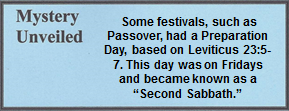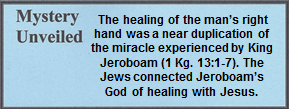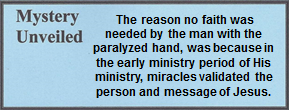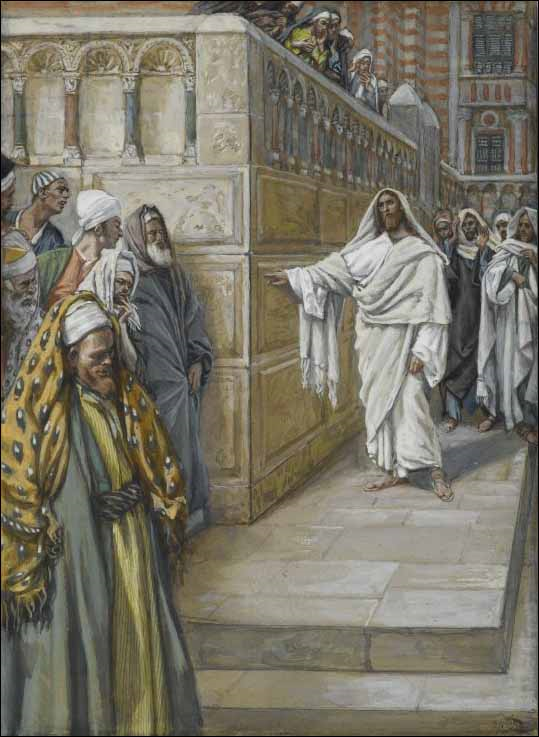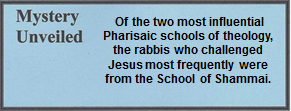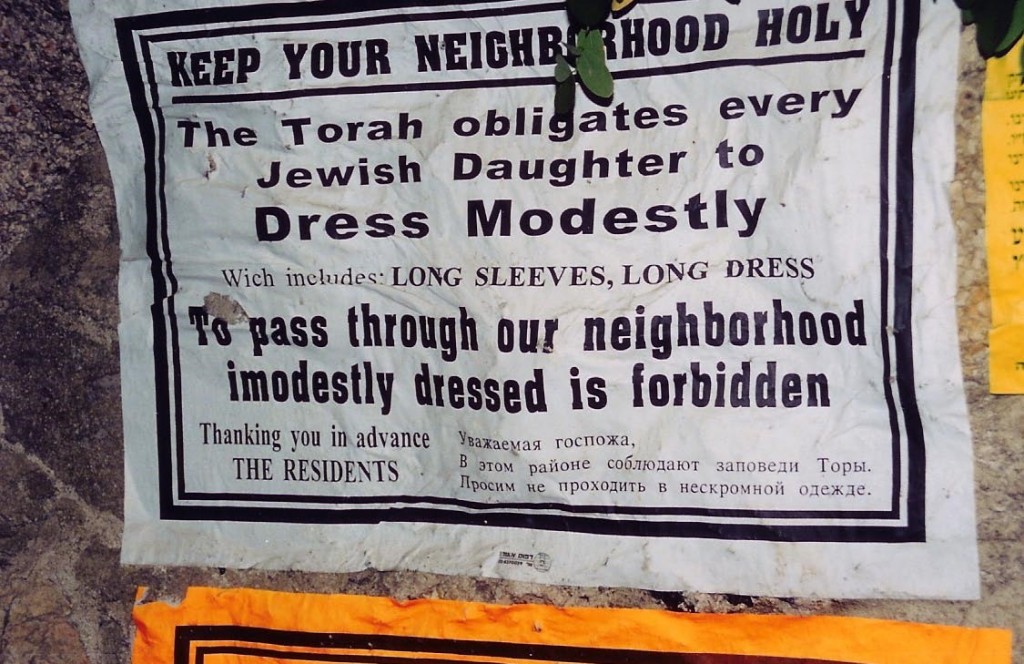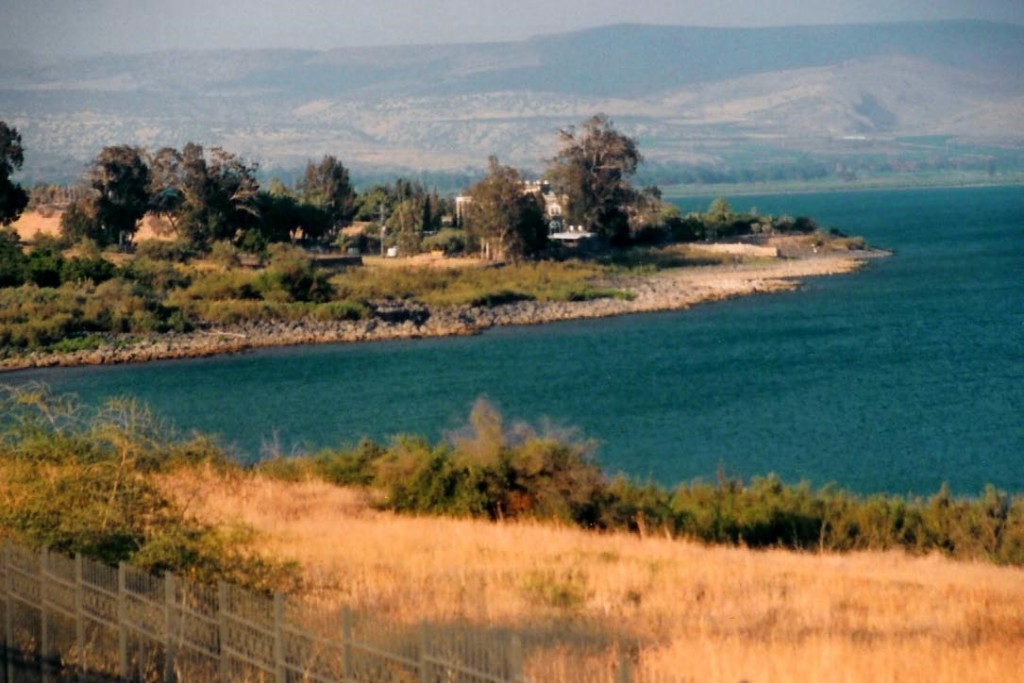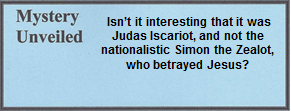07.03.05 Mt. 5:1-12 (See also Lk. 6:20-23) Spring A.D. 28 Capernaum
THE SERMON ON THE MOUNT
1 When He saw the crowds, He went up on the mountain, and after He sat down, His disciples came to Him. 2 Then He began to teach them, saying:
3 “The poor in spirit are blessed,
for the kingdom of heaven is theirs.
4 Those who mourn are blessed,
for they will be comforted.
5 The gentle are blessed,
for they will inherit the earth.
6 Those who hunger and thirst for righteousness are blessed,
for they will be filled.
7 The merciful are blessed,
for they will be shown mercy.
8 The pure in heart are blessed,
for they will see God.
9 The peacemakers are blessed,
for they will be called sons of God.
10 Those who are persecuted for righteousness are blessed,
for the kingdom of heaven is theirs.
11 “You are blessed when they insult and persecute you and falsely say every kind of evil against you because of Me. 12 Be glad and rejoice, because your reward is great in heaven. For that is how they persecuted the prophets who were before you.
The Sermon on the Mount, a/k/a “The Beatitudes,” is undoubtedly the most famous sermon of Jesus. It provides a highly valued picture of the Kingdom of God while earthly values are greatly diminished; it is a collection of paradox and contradiction.[1] There are no woes or curses, but clear separation between those who are blessed and those who are not. With this sermon, He affirmed many teachings found not only in the Old Testament, but also those taught by many righteous rabbis of His time.[2] In fact, the ten blessings are reflective of the Ten Commandments which were confirmed by Him as well.[3] He accomplished three points.
- He challenged the Pharisees and Sadducees on their restrictive laws.
- He supported righteousness of the Mosaic Law perspective, but also
- Went beyond the goals of the Law of Moses to clarify the principles of God.
Just as the Ten Commandments are first focused on man’s relationship to God, then man’s relationship with other people, so likewise, is the Sermon on the Mount. Notice the following structure:
In relationship to God, Jesus said:[4]
- “Blessed are…the poor in the spirit…” Jesus said this means to have the correct understanding of oneself before God
- “Blessed are…they that mourn…” Jesus said it means to develop sensitivity to sin and what God thinks about it.
- “Blessed are…the meek…” This means to have a peaceful confidence in God and recognize His authority
- “Blessed are…they that hunger and thirst after righteousness…” Jesus desires that people desire Him passionately.
In relationship to man, Jesus said:
- “Blessed are…the merciful….” Jesus desires His followers to be kind to others, especially when they have been wronged, and to respond to their needs.
- “Blessed are…the pure in heart….” Jesus meant that all should have the highest level of integrity and have only a proper motivation.
- “Blessed are…the peacemakers….” To be a peacemaker is to convey the peace of God upon men, even if it means conflict, which He later promised it would. To be a peacemaker includes developing unity among the believers.
- “Blessed are…they that have been persecuted for righteousness sake ….” Jesus promised that those who would hold His standard would be rejected, just as He was, and they would be persecuted. But they will be justly rewarded.
- “Blessed are you when men shall reproach you, and persecute you…for My sake.” Jesus said that those who accept His Messiahship may be rejected by family and friends.
In essence, the purpose of the Sermon on the Mount is to encourage the people to seek the higher righteousness of the Kingdom of God – the principles of God. Jesus essentially challenged His audience with the question, “What kind of life is worth living?” The Sermon comprises the basic elements of what would become Christianity, or as Jesus said, the Kingdom of God. The summary statement for the Sermon is found in Luke 6:32-36 encouraging men to be perfect as the heavenly Father is perfect. However, man cannot possibly be perfect, but he can have a “holy attitude” of becoming perfect and that is what God expects. In essence, one is to love Jesus so much that the thought of sin is repugnant. The Sermon gives characteristics of what Jesus wants His followers to become. Yet near the end, He offers the promise of persecution that would help spread the gospel. Amazingly, the modern student may be surprised to know that some rabbis were teaching this as well, but their teachings are lost in the pool of many other rabbinic opinions of the day.[5]
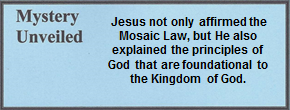
In Matthew 5:1-12 Jesus described the blessed life that results from faith and a lifestyle built upon His teachings, which actually have Hebraic roots. He gave the elements of a righteous man (Mt. 5:3-16) followed by His condemnation of the Pharisaic interpretation of the Law (Mt. 5:17-48). Then He denounced how the Old Testament was being implemented (Mt. 6:1 – 7:6) and how the aristocrats had violated it themselves in their vain attempts to observe it. Jesus taught the holiness of God to those who desired to enter His kingdom (Mt. 7:7-29) and promised blessings to those who obeyed these divine instructions, which was in sharp contrast to the condemnation of the Pharisaic self-righteousness. In essence, believers should not regard the statements of Jesus in Matthew 5:28, 32, 34, 36, and 44 as setting aside the Law, but as reflecting His authority by giving proper interpretation of the Law.
According to the book of Hebrews, the laws pertaining to the sacrifices and feasts in the book of Leviticus[6] are a “type and shadow” of what was to be the ministry of Jesus. In other words, the Sermon fulfills the objectives of the Torah. The Law given by Moses pertained only to an act, whereas the Law given by Jesus pertains to the motivation of a person’s heart that is behind the act. Jesus did not come to end the Law, but to fulfill it. Believers are no longer under the Law of Moses but under a new law, the Law of Messiah because Jesus was the fulfillment/goal/purpose of the Law of Moses.[7] In fact, it might more correctly be said that Jesus did not come to end the law, but to reveal it. But on an important side note, the Church has adopted a Roman view of law, that it means restriction and, is therefore, bad, while the Hebrew Bible views law as instruction and freedom, and is therefore, good.[8] Jesus must be understood as the messianic interpreter of the intent of God’s Word. This is not only seen here, but throughout His entire life. For that reason, a good understanding of the Hebrew Bible is necessary before attempting to comprehend an in-depth study of the New Testament.
For example, there are six antithetical statements in Matthew 5:21-47. Each one begins with, “You have heard it said…” and this is followed by a Torah text. Every time Jesus gave the requirements of the Mosaic Law, it was followed by the intent of God. This astounded His audience. Matthew teaches that, rather than having mankind be directed by external laws of the Old Covenant, God desires to live within mankind to direct man to live godly according to the New Covenant. That is the definition of the “Kingdom of God.”[9]
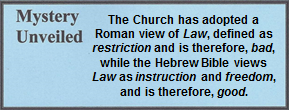
Imagine what people must have thought when He told them “blessed were those who mourned … those who are meek … the merciful … and the peacemakers.” He began to reshape their preconceived ideas of how God felt about them and what God wanted for them. There was not a single person unaffected by the economic slavery of the Romans or ethnic tensions.[10] People came expecting to hear how they could have peace and freedom in the land. Instead, they heard how they could have peace and freedom with God. Consequently, there was a great debate of who He was and whether He could be the long-awaited messiah.
Social, political, and religious tensions were also at an explosive point. Those who say the life and times of Jesus cannot be compared to the challenges of modern life today fail to understand the times in which He lived. Often, it was worse. In the midst of this human misery and suffering, Jesus came to give compassion, mercy, salvation, and a bright future of hope. In the Sermon on the Mount, He simply clarified many teachings of the Hebrew Bible that gave them hope and purpose.
“The poor in spirit.” This phrase means one realizes his spiritual condition is impoverished and, therefore, he must depend on the grace and mercy of God.[11] The Greek term ptochoi is defined as the most destitute in poverty.[12] It is the direct opposite of pride. The Essenes understood that the term the poor in Isaiah 29:19 was not a reference to the economically deprived, but to those who were spiritually impoverished. Their ideas were expressed in Hymns of the Poor, found in Dead Sea Scroll fragments 4Q434 and 4Q436. The term poor in grace, with the same meaning is found in fragment 1QH 5.22 in which the Essenes described themselves.[13] Most certainly the Sermon of the Mount captured their attention.[14] Those who are destitute in spirit, who are spiritually broken before Almighty God, will realize and appreciate their need for Him.
“Blessed.” The term in Hebrew is baruk and in Greek is makarious.[15] The word means to praise God with a sense of happiness and joy upon man.[16] More specifically, it refers to a quality of spirituality that is already present.[17]
07.03.05.Q1 What are the differences between Old and New Testament blessings?
There are two other terms that need to be clarified since both Testaments use the term “blessed.”
- The term “beatitudes” is commonly ascribed to this passage and is derived from the Latin word “beatus,” meaning “blessed.”[18] In Hebrew the word is baruk (Gk. makarios 3107),[19] but the Latin and English terms not as specific as the Greek and Hebrew words.
- Another term to be considered is the Hebrew word beraka (Gk. eulogeo 2127) that also means blessed.[20] This term is used in the Old Testament, but not in the Sermon on the Mount. It is the ideal word to use when asking God to bless the sick or someone who has experienced a misfortune. It is used in prayer when the worshipper blesses God or the object of his prayer.[21] However, the word makarious affirms the quality of spirituality that is already present.[22] The difference is that in the Old Testament the goodness within a person brought forth God’s blessings and in the New Testament the divine blessings are present for the believer.[23]
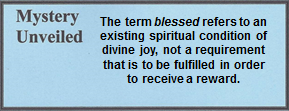
Just as God had given the Law to Moses on a mountain, now Jesus explained the principles of the Kingdom of God, on a mountain. After discussing the concepts of Moses with His new Kingdom,[24] He gave the characteristics of a new life in the kingdom, including its devotion, duties, and dangers.
“Kingdom of heaven.” This was His main theme, which was equal to the Kingdom of God in every detail (cf. Mt. 5:3 with Lk. 6:20). Matthew’s gospel was written to a Jewish audience, who gave such high respect to God’s name that he did not mention it in conversation or write it. This is still true in many orthodox Jewish communities today. Other gospel writers use the phrase “Kingdom of God” to mean the same thing when speaking to a Gentile audience.
The Greek word for “kingdom” more specifically, means dominion, as opposed to a large expanse or territory of land. Today dominion and kingdom can be synonyms, but the distinctions were not as close in the first century. The word dominion should have alerted everyone that Jesus was not interested in being a military-messiah.[25]
“Those who mourn are blessed.” The phrase signifies grief that is too deep for concealment and is often associated with terms that express audible weeping.[26] It is a reference to the sorrow and mourning of past sins (Isa. 61:1-3). Jesus said they are blessed because they will be comforted.[27] Matthew’s phrase is an abbreviation, meaning “poor and crippled in spirit.” These people are spiritually “down and out,” to use a modern term.[28] It has been said that success and prosperity does not make one wise, but failure and suffering brings forth wisdom as well as an appreciation for life. That may be why King Solomon wrote:
Grief is better than laughter,
for when a face is sad, a heart may be glad.
Ecclesiastes 7:3
“The merciful are blessed, for they will be shown mercy.” The English term mercy is translated from the Greek phrase eleemon, meaning sympathetic. However, the unique feature of mercy is that this attitude is not merciful unless accompanied by action when it is within one’s ability to aid someone else who is in need of mercy. God responds to His believers in the same manner they respond to others. A negative example is the Pharaoh of Egypt. After he hardened his heart against God, God did likewise to him (Ex. 8).
“The pure in heart.” This phrase refers to the motives of the heart; not only single-minded toward God, but also passionate to have the desires that God desires. Throughout history people have struggled with their sinful desires and tried to maintain self-control to obey the biblical commands. This does not refer to a sinless life, but rather, to a heart after God; seeking His forgiveness when needed.[29] That is, purity (Gk. katharos ) defined within the realm of physical, religious, and ethical purity; a term that has both figurative and literal requirements of behavior.[30] Those who have that desire to be obedient are said to be “pure in heart.” This concept was radically different from what the attending Gentiles believed. They thought that being as immoral as their pagan gods was a blessing.[31]
“The peacemakers are blessed.” This was a powerful statement since Galilee was a short distance from the villages of Gischala and Gamla, two strongholds of anti-Roman sentiment and Jewish nationalism. Everyone listening knew Jesus made a reference to the history of social-political struggles that had plagued them for more than a century, as well as to the Zealots – the guerilla fighters who encouraged Jews not to pay taxes to Rome.[32] From the time the Romans conquered Jerusalem in 63 B.C. to when they destroyed the city and its temple in A.D. 70, there were 13 revolts and many minor skirmishes. Jesus came and ministered in the middle of this chaotic period.[33]
However, the words of Jesus went beyond a type of nationalistic peace; He spoke of peace within the heart when the world seems to be falling apart. The Hebrew word shalom, means peace in English, but is far more than the absence of war. Shalom holds a broader concept which includes one’s well-being, wholeness, health, and spiritual life as portrayed numerous times in the Bible.[34] No doubt, Jesus reflected upon the oral tradition of Aaron, who not only loved peace, but also pursued peace. Hence, He was truly a peacemaker. The peacemaker is one who is willing to pay a price to attain peace, either for himself or for someone else. This may be why God gave Aaron the benediction blessing of Numbers 6:23-26 and, hence, he was known as one who deeply desired peace as defined above. Aaron was a priest and, as such, functioned as a representative of the people before God to obtain forgiveness of their sins and bring peace and wholeness into their lives, although Jesus is the ultimate peacemaker. Peace was considered to be a gift of God for the study of the Torah.[35]
The entire discussion of blessed are the merciful…peacemakers is a reflection upon the sixth commandment as it pertains to murder. Jesus was not talking about capital cases, military action, or the differences between premeditated murder and involuntary murder.[36] Neither did He discuss punishment as a deterrent. Rather, He taught the principles of daily righteous living. He was concerned with removing the motivation of violence, which would otherwise lead to military action, murder, etc. Just as the Pharisees had established a “fence around the Torah” with their Oral Law, so Jesus established a “fence around the Ten Commandments” with His Sermon.[37] This concept of a fence can also be seen in His instruction concerning adultery, to which He essentially said, “Don’t even think about it.” (cf. Mt. 5:8; Ps. 37:18). There is no need for prisons and capital punishment for those who live in forgiveness and are merciful peacemakers.[38]
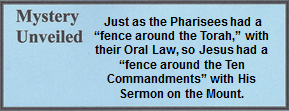
Finally, on an interesting side note, could the Sermon of the Mount have influenced the residents of the small Zealot town of Gischala and a young man named Saul who lived there? Twice Jerome, a Latin priest (347-420), mentioned that Paul’s parents once lived in that northern Galilean town. Therefore, Saul as a young child must certainly have had personal experience with military tension and conflict, which, no doubt, shaped his attitude toward the Romans and his fellow Jews. That ancient village is believed to be the town of Jish today.[39]
Paul, formerly Saul, an apostle outside the Twelve, came from the tribe of Benjamin and the Judean town of Gischala. He was captured by the Romans and came with his parents to Tarsus in Cilicia.
Jerome, De Viris Illustribus (PL 23,646) 76
It is reported that the parents of the Apostle Paul came from the Judean region of Gischala. When the whole province was destroyed by the Romans and the Jews were dispersed over the world, they were taken off to Tarsus, while the young Paul followed his parents in their fate.
Jerome, Commentary on Philemon (PL 23,645-6)
According to Josephus, the village of Gischala was a hotbed of Zealot activity, which is why the Romans destroyed it at the beginning of the Second Revolt in A.D. 66.[40] If Jerome’s account is true, then some rather interesting events must have occurred that would enable the father of Saul (later known as Paul) to receive Roman citizenship. Nonetheless, Josephus made no mention of the apostle, only that the Romans destroyed the village. But could the young Saul have heard the sermons of the Kingdom of God before his own calling? Most certainly he did.
07.03.05.Q2 How does one explain the apparent Sermon on the Mount disagreement between Matthew 5:1 and Luke 6:20?
When describing the location of this teaching, Matthew said Jesus, “went up on a mountainside and
sat down” (5:1), while Luke said that He simply “stood on a level place” (6:17). To solve this apparent problem one needs only to travel to the site and see the lay of the land with its rolling hills. There are level areas on the side of the large hill that Matthew referred to as a mountainside. Jesus no doubt moved among the people for all to hear as He taught and healed them. A visit to the Galilee area will reveal that there are occasional level areas on the sides of hills. Furthermore, a visit there will impress the visitor as to how well sound travels. He was easily heard where the curved hillsides create a natural amphitheater.
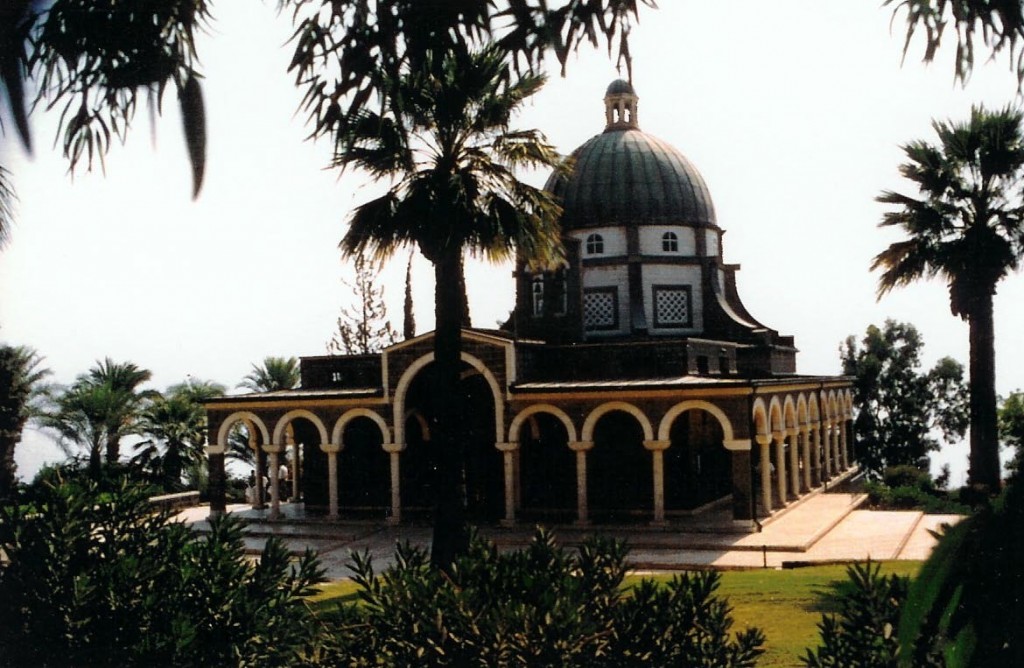
07.03.05.B. THE POPULAR SITE OF THE SERMON ON THE MOUNT. On a small mountain top along the Sea of Galilee, one can easily imagine Jesus teaching His disciples and others who desired to listen. Photograph by the author.
While the above site is the most popular site for where Jesus taught the beatitudes, it certainly is not the actual location. This mountain top location was selected as a tourism center in 1937 and funded by the famous Italian dictator, Benito Mussolini. Ironically, the location of the actual site near Capernaum (above) was preserved by a Spanish Pilgrim in the year 384 and, is considered to be the authentic location (see below) by many scholars.
As to the two passages, Matthew’s sermon (Ch. 5-7), has some unique differences from, and similarities to, the sermon recorded by Luke (6:20-49). From Augustine until the Reformation, the church had always considered these to be two separate events and sermons. Since the Reformation, these narratives have been considered by some scholars to be the opinions of two gospel writers who wrote of a single event – a sermon given only once.[41] However, now there is a growing interest to return to the Augustinian opinion. The Lucan narrative has sufficient differences that it should be called the Sermon on the Plain. What all agree upon is that these two narratives are only a small portion of His many teachings. The key point is that throughout His ministry Jesus preached the same theme repeatedly and the difference between the two sermons is simply that it was most likely presented to two different audiences. It would only be natural for a variation of wording, even if the theme remained the same. Jesus was an itinerant preacher, who traveled throughout the three Jewish provinces of Judea, Perea, and Galilee, as well as in Samaria and the Gentile areas. No one knows how many times He preached His simple message of the Kingdom of Heaven/God. Since this subject was a focus of His ministry, He obviously preached it many times. Whether the two sermons are of the same event is hardly the point. It is the message that is significant. All recorded teachings, miracles, and other events of Jesus barely add up to one hundred days of His life, so He probably preached this subject numerous times. This writer follows the Augustinian teaching, treating the two narratives as two separate events.
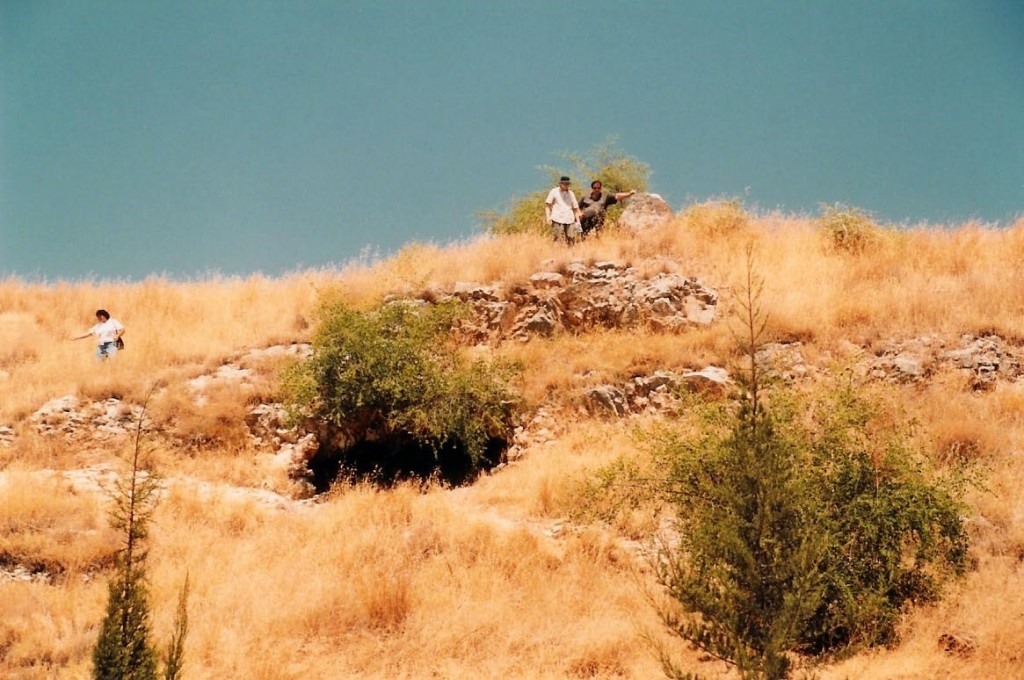
07.03.05.C. THE ACTUAL SITE OF THE SERMON ON THE MOUNT. The Spanish Pilgrim Egeria identified the cave and the top of this hill in A.D. 384 as the place where Jesus gave His Sermon on the Mount. The site is adjacent to the international highway, the Via Maris, and can easily accommodate hundreds of people. The slope and atmosphere provide ideal conditions for one’s voice to be heard easily at a great distance. The cave, that can accommodate up to a dozen people, is where tradition says Jesus stayed with His disciples. Photograph by the author.
For three years (381-384), the Spanish Pilgrim Egeria and her entourage traveled throughout the Holy Land visiting various sites.[42] According to the Pilgrim, in 384 she came to the place where Jesus taught and said it was only a couple hundred feet from the popular Via Maris. This gave locals and travelers easy access to hear Him preach. The hill is truly a “mount” and is located between Capernaum and Magdala at the northwest corner of the Sea of Galilee, hardly a hundred yards from the highway. This setting makes perfect sense, as Jesus would not have exhausted people by making them climb a distant and higher mountain to hear Him preach at today’s popular Mussolini site. Egeria left this valuable record of her visit to the Capernaum area:
In Capernaum, a church was made out of the house of the prince of the Apostles, the walls of which are standing to this day just as they were. That is where the Lord healed the Paralytic (cf. Mk. 2:2-12)…. The synagogue is also there in which the Lord healed the possessed man (cf. Mk. 1:23-26)…. The visitor climbs up to it by several steps; this synagogue is built out of square blocks of masonry. Not far from there, the stone steps can be seen on which the Lord stood (cf. Jn. 21:4)…. Above the lake there is also a field of grass with much hay and several palms. By it are the seven springs,[43] each of which supplies a huge quantity of water. In the field the Lord fed the people with five loaves of Bread (cf. Mk. 6:31-44)…. The stone on which the Lord placed the bread has been made into an altar. Visitors take small pieces of rock from this stone for their welfare and it brings benefit to everyone…. Along the walls of the church runs a public highway where the apostle Matthew sat to collect taxes (cf. Mk. 2:13-14)…. On the hill which rises nearby is a grotto, upon which the Lord ascended when he taught the Beatitudes (cf. Mt. 5:1).
Pilgrim Egeria[44]
Israel has no shortage of so-called traditional sites. A third location for the site of the Sermon on the Mount is the top of a mountain known as the Horns of Hattin, an extinct volcano that is near the ancient road between Nazareth and Tiberius.[45] This, and many other so-called traditional holy sites were created by the Crusaders so European pilgrims could travel from one site to another with relative ease in a small geographical area. The irony is that just as some traditional sites were chosen for the ease of visiting pilgrims a thousand years ago, so was the current site of the Mount of the Beatitudes in the 1930s. Of all the places Jesus could have chosen to preach this famous sermon, He chose a hilltop. Perhaps the hilltop is a “reflection” of when Moses gave the laws of God to his people. Notice the comparison in poetic style:
Moses defined how people were to live while
Jesus declared the heart of God.
The Oral Law was thought to produce the ideal disciple of Abraham.
But Jesus gave instruction that would produce the ideal disciple of God.
The Sermon adapts and extends scriptural concepts into the issues of everyday life and was not intended to be a form of doctrine. While the Oral Law of the leading Pharisees was extremely legalistic and restrictive, Jesus gave freedom and liberty. The Sermon on the Mount illustrated how the Kingdom of God will change individuals and the world.[46] His sermon was then followed and ratified by a series of mighty signs and wonders.
Highways have always been important in the Middle East, especially in this narrow section of land that was transversed by armies and merchant caravans for thousands of years.[47] During the Inter-Testamental period, many traveled from foreign countries to bathe in the hot springs in the Jordan River Valley, hoping to get healed from a variety of diseases. In the days of Jesus, they came to get healed but also heard His sermon about a coming Kingdom of God. The Romans built excellent roads and offered incredible freedom of movement – more than ever before. This enabled people to listen to Jesus and helped the gospel reach distant areas of the Empire.[48]
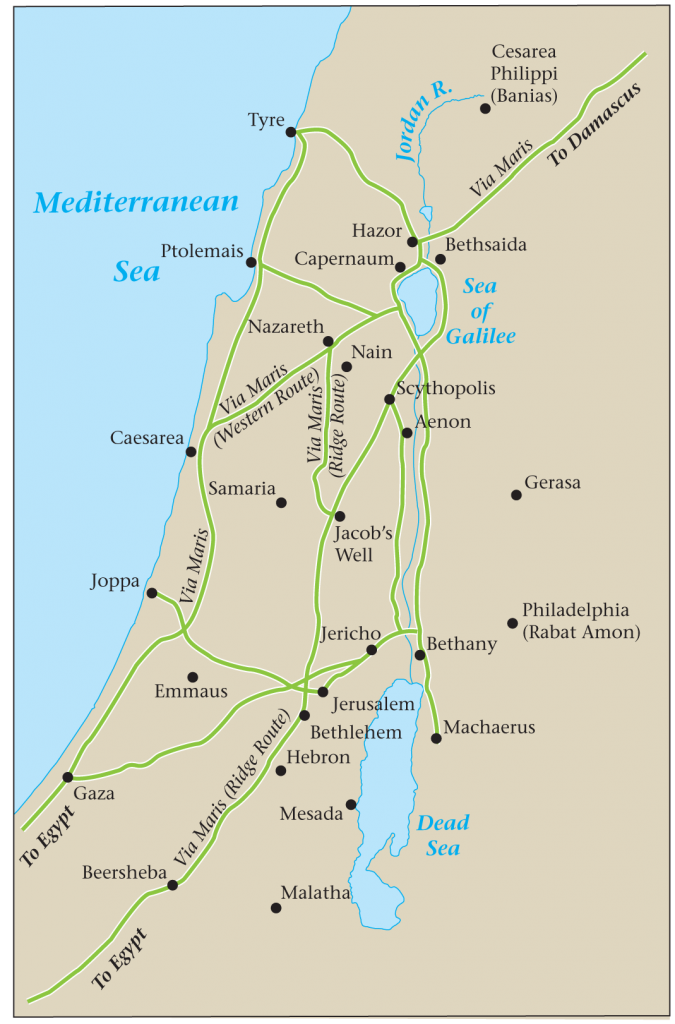
07.03.05.Z MAP OF MAJOR ROADS IN 1ST CENTURY ISRAEL. Most major roads between the continents of Europe, Asia, and Africa led toward the Sea of Galilee where caravans were resupplied with fresh food and water before continuing their travels. It was in the Capernaum area where Jesus taught and performed miracles, so news of His ministry spread quickly through the known world. Courtesy of International Mapping and Dan Przywara.
[1]. Metzger, Goldstein, and Ferguson. Great Events of Bible Times. 146.
[2]. For further study see, Georg Strecker. The Sermon on the Mount: An Exegetical Commentary. Trans O.C. Dean, Jr. (Nashville: Abingdon Press, 1988); Brad H. Young. The Jewish Background to the Lord’s Prayer. (Tulsa, OK: Gospel Research Foundation. 1984); and Gerald L. Stevens. “Understanding the Sermon on the Mount: Its Rabbinic and New Testament Context.” The Theological Educator. 46 (Fall, 1992) 83-96.
[3]. See Appendix 4.
[4]. See the use of the Blessed (Gk. makarios) in Appendix 26. See also Vine, “Bless, Blessed, Blessedness, Blessing.” Vine’s Complete Expository Dictionary. 2:69.
[5]. See video 02.02.16.V by Messianic Rabbi John Fischer who discusses this subject briefly from a first century Jewish perspective.
[6]. See Appendix 4.
[7]. Rom. 7:5-6, 10:4; Heb. 7:11-19, 8:13; Col. 2:14; Eph. 2:11-3:6; Gal. 3:17-19.
[8]. See video 08.01.06.V by Messianic Rabbi John Fischer who discusses the term “light and heavy” elements of the Mosaic instruction from a first century Jewish perspective. He also adds a comment about the definition of “Torah” as it means “guidance” or “instruction.”
[9]. For a study of Jewish covenants from a messianic Jewish perspective, see Arnold Fruchtenbaum, Israelology: The Missing Link in Systematic Theology.
[10]. Sanders. “Jesus in Historical Context.” 430.
[11]. See “Natural Expressions by Jesus without Quotations” in Appendix 12.
[12]. Lang, Know the Words of Jesus. 101.
[13]. Charlesworth, Jesus within Judaism. 68-70.
[14]. Bailey, Jesus throught Middle Eastern Eyes. 138; Eisenmann, Robert H. and Michael Wise, The Dead Sea Scrolls Uncovered. Rockport, Mass., Element. 1992. 237.
[15]. Becker, “Blessing, Blessed, Happy.” 1:206; Lang, Know the Words of Jesus. 100.
[16]. Weasel, “Blessed.” 1:201.
[17]. Bailey, Jesus through Middle Eastern Eyes. 66-68; Vincent, Word Studies in the New Testament. 1:35-36.
[18]. Freeman, The New Manners and Customs of the Bible. 407.
[19]. Vine, “Blessed.” Vine’s Complete Expository Dictionary. 2:70.
[20]. Vine, “Blessed.” Vine’s Complete Expository Dictionary. 2:69.
[21]. Bailey, Jesus through Middle Eastern Eyes. 67.
[22]. Bailey, Jesus through Middle Eastern Eyes. 66-67; Vine, “Blessed.” Vine’s Complete Expository Dictionary. 2:70.
[23]. Richards, The Bible Reader’s Companion. 538.
[24]. His new Kingdom (Mt 5:1-16); the Law of Moses (Mt 5:17-18).
[25]. To exchange a noun for another or related noun is not uncommon in the Hebrew the Law. It makes little difference whether the writer wrote in Greek or Hebrew, because his thinking process was still Hebraic. See also Bullinger, Figures of Speech Used in the Bible. 580.
[26]. See Mk. 16:10; James 4:9; Vincent, Word Studies in the New Testament. 1:36-37; Lang, Know the Words of Jesus. 218.
[27]. Jesus gave a number of “natural expressions,” that is, expressions that convey the larger message of the Old Testament gospel. Examples are found in Appendix 12.
[28]. Bivin and Blizzard, Understanding the Difficult Words. 81-82.
[29]. See also Jer. 17:9; Ps. 24:3-4; 32:1-5; 119:104; 139:23-24.
[30]. Link and Schattenmann. “Pure, Clean.” 3:102-03.
[31]. Jesus often had traveling Gentiles in His audience, especially at the Sermon at the Mount location, since that was given only a short distance off the Via Maris.
[32]. See “Zealots” 02.01.22.
[33]. See Appendix 25 for a listing of false prophets who had messianic expectations and for a partial listing of revolts and social disturbances from 63 B.C. to A.D. 70.
[34]. A few passages are Prov. 17:1; 20:3; 26:17; Gal. 5:20-21, and 2 Cor. 3:3.
[35]. Isa. 54:13; Mishnah, Aboth 1:12.
[36]. Mishnah, Makkoth 1:9-2:8.
[37]. See video 02.02.16.V by Messianic Rabbi John Fischer who discusses the term “fence around the Torah” from a first century Jewish perspective.
[38]. Charry, By the Renewing of Your Minds. 73.
[39]. Pixner, With Jesus through Galilee. 77.
[40]. Josephus, Wars 4.3.8-14.
[41]. Carson, “Matthew.” 8:125.
[42]. She was a nun from Galicia, in northwest Spain. Shanks, “After Hadrian’s Banishment: Jews in Christian Jerusalem.” 32.
[43]. The Seven Springs today is known as Tabgha, which is a corruption of Heptapegon which means “seven springs.” It is located one and a half miles west of Capernaum. Josephus called the largest of these “the well of Capernaum” (Wars 3.10.8).
[44]. The letter is in the possession of the Benedictine Library of Monte Cassino. The contents of original parts that were lost have been preserved by copies. Pixner, With Jesus through Galilee. 36.
[45]. Gilbrant, “Luke.” 179.
[46]. Charry, By the Renewing of Your Minds. 64-65.
[47]. See comments by Dr. Bill Heinrich and Professor Gordon Franz in 05.05.03.V “The Strategic and Economic Significance of Capernaum.”
[48]. Mellowes and Cran, Producers. From Jesus to Christ: The First Christians. (DVD). Part 2.
